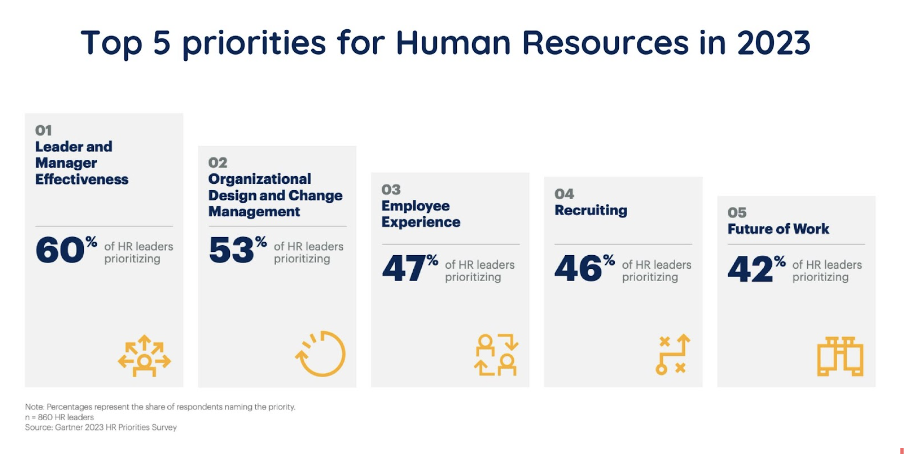Rising inflation, the Great Resignation, the war for talent, supply chain problems… HR managers have had to confront many challenges in the post-COVID age. The most important one is to strike the right balance between the needs of the organization and those of employees. So, what are the HR trends to watch for in 2023? And which ones should your organization prioritize? To dive deeper into this topic, we analyzed the latest Gartner study, which identified five top priorities for HR in 2023, namely:

Here is an overview of these five HR challenges and the actions to be taken to address them.
Also read: Human Resources: 5 Priorities for 2021 According to Gartner
1. Management effectiveness
In 2023, 60% of HR managers want to focus on the effectiveness of managers, including their ability to manage humanely, without neglecting performance.
Indeed, the human factor plays an increasingly important role in business. To be a “good manager”, you need to develop the three soft skills that make each of us human: authenticity, empathy, and adaptability.

To help managers put people at the heart of their concerns, human resources must first change the managerial skills development processes in place in their organization—processes that, for 24% of HR managers, do not prepare managers well enough for the future of work.
The objective of HR in 2023 is to adopt a new strategy for developing skills that gives greater value to freedom of speech and is better adapted to the needs and working methods of teams.
Also read: Hybrid Work: Management Best Practices
2. Change management
Another HR priority in 2023 is change management and organizational development. 45% of HR managers believe that their employees are tired of the changes they’ve had to undergo in recent years. This problem tends to reduce employees’ sense of belonging and generate more conflicts at work, and this ultimately leads to increased turnover.
According to Gartner, 43% of employees who experience above average “change fatigue” plan to stay with their company, compared to 74% of those with less change fatigue.

To limit this “change fatigue”, human resources must opt for a more open, collaborative, and less top-down change management strategy. This approach means involving employees throughout the process—not just telling them what’s going to change.
With this strategy, both employers and employees benefit because:
- Employees can be actors of change, participating in both the decision making and the implementation of the various changes.
- Organizations are 14 times more likely to succeed in change management.
This is one of the key trends to follow for human resources in 2023!
3. The employee experience
We’re hearing more and more about the employee experience, and rightly so, as nearly half of HR managers plan to invest in it by 2023. Specifically, HR wants to prioritize career paths. According to Gartner, these are no longer enough to convince employees to stay with their company.
In fact, only one in four employees say they are confident about their career in the company for the long term. Not surprising then that employees decide to go elsewhere!
To avoid this brain drain, human resources has to improve the employee experience, starting with a review of the career management process. The key is to:
- Explain career development opportunities to employees better.
- Share concrete examples of how to illustrate the different career path options available.
- Offer objective spaces for reflection to create career plans that are better adapted to employees’ needs and skills.
Also read : How The Digital Workplace is Transforming the Employee Experience
4. Recruitment
More than just an HR trend, recruitment is one of the key HR priorities for 2023. After all, since the Great Resignation, recruiting new talent isn’t as easy as setting up a both at a job fair.

36% of HR managers surveyed by Gartner say their sourcing strategies are insufficient to find the skills they need.
If HR wants to attract more talent, it needs to develop a robust recruitment strategy that is relevant to the current environment. To achieve this, Gartner recommends that HR managers:
- Leverage market data to find accessible talent, identify skills, location, and roles that could match identified needs.
- Seek out skills both internally and externally to expand the talent pool and create equal opportunities.
- Personalize the onboarding process to better suit the needs of each employee, and connect the role to the company’s missions.
5. The future of work
In 2022 as in 2023, the future of work remains one of the key trends in human resources. A future synonymous with hybridization, both in terms of work modes and workforce.
To anticipate it, you need to start by reviewing your workforce planning, which is often out of touch with reality. Why’s that? Many companies still believe they can predict the skills they’ll need tomorrow, find talent with the snap of a finger, or even dictate where, when, and how their employees work.
While these assumptions may have been true before COVID hit, they’re no longer the case. The priority for HR in 2023, then, is to adopt a new approach to workforce management that better addresses today’s HR challenges, including:
- the rapid evolution of skills
- talent shortages
- high staff turnover
- the evolution of the employee-employer dynamic
Here are three keys to success in implementing this new strategy:
- anticipate changes that could affect critical roles in the short term
- reassign tasks flexibly within your organization
- test new recruitment methods
- offer everyone the means to work the way they want
*
* *
Now you have all the keys you need to run your HR in 2023. These trends are of course destined to continue evolving, so you should regularly monitor the latest news and changes in your sector and adapt your HR strategy accordingly and routinely.
Want to learn even more about what the future of work will look like? Download our white paper on this very topic:
Access the White Paper
This article is an extract from the White Paper “Future of Work: Make Way for Hybrid Work!.” You’ll discover: the eight main challenges of hybrid work; best practices for managers, HR, communication, IT, and employees to adopt; as well as the tools to implement to facilitate hybrid work.



![[Expert Opinion] Steps for Achieving a Successful HR Transformation](https://blog.talkspirit.com/wp-content/uploads/2024/02/Achieving-HR-transformation-400x250.jpg)
